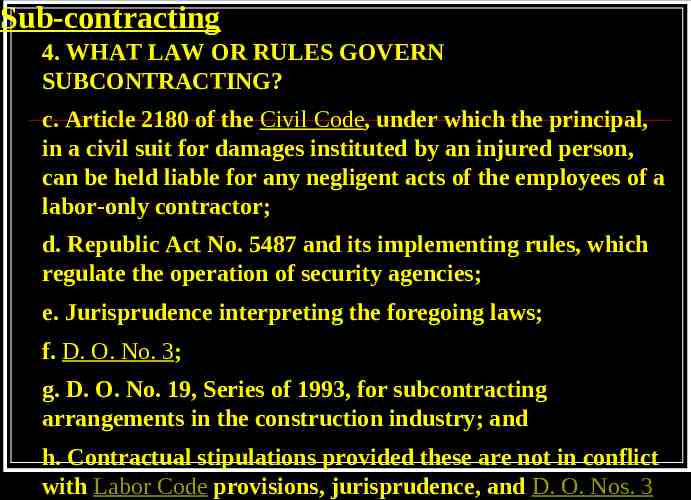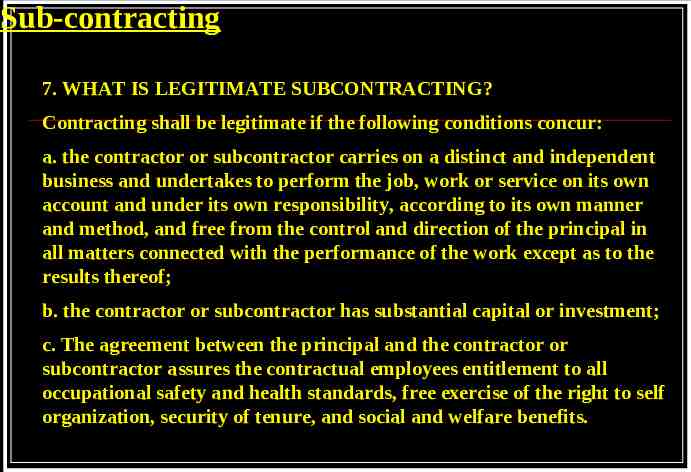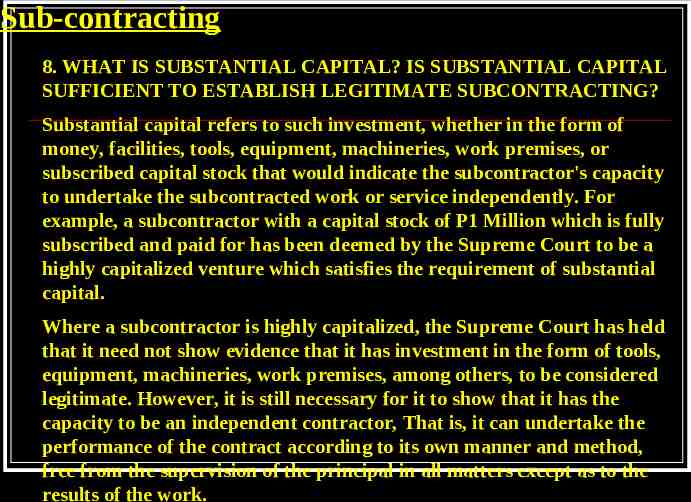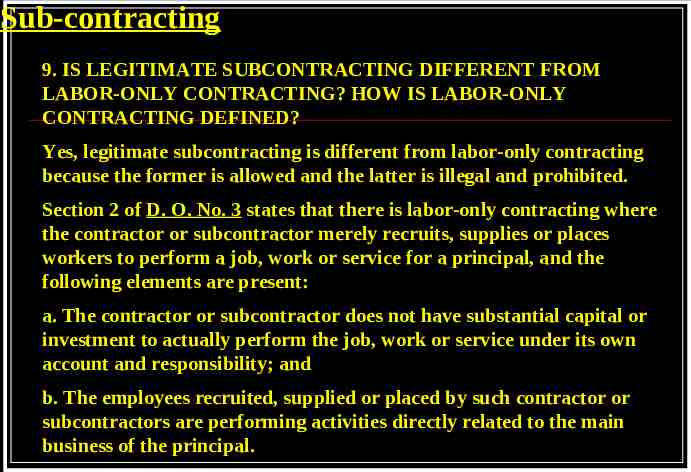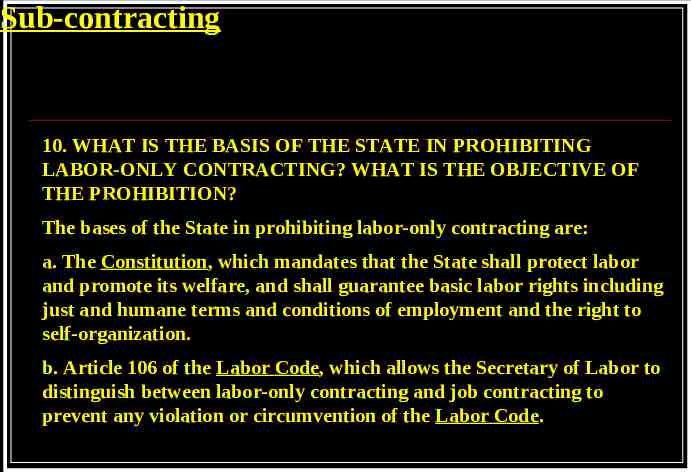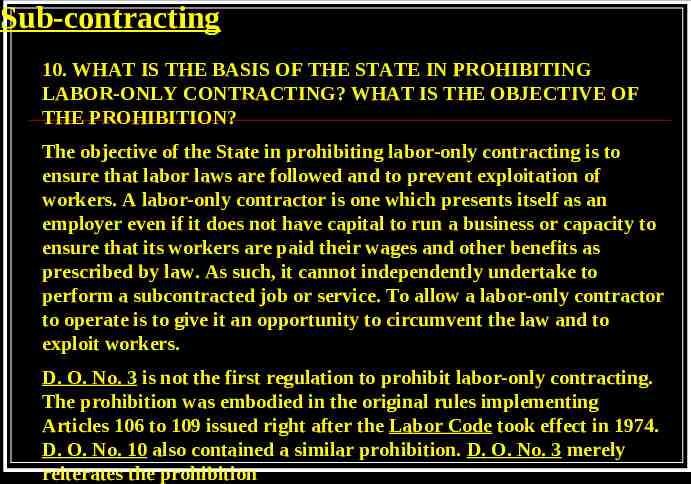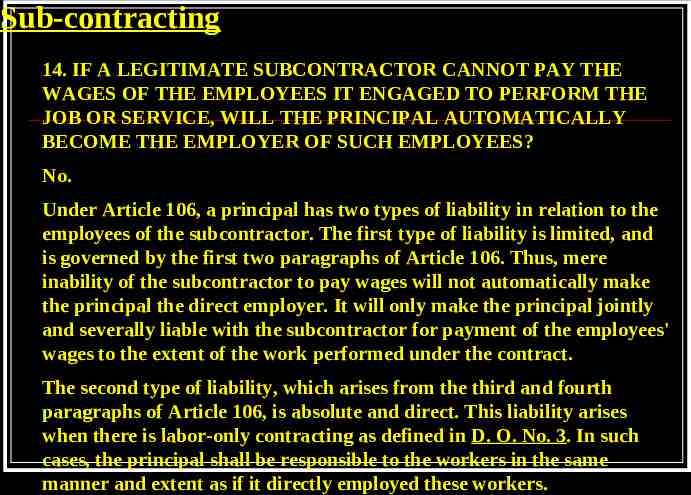CONTRACTS ASUAR, BRYAN JERICK L. BALINGIT, PHILIP M. DIMAPINGUN,
97 Slides528.00 KB
CONTRACTS ASUAR, BRYAN JERICK L. BALINGIT, PHILIP M. DIMAPINGUN, ANGELA C. MACASERO, ORLIE ORLAN D. MONTES, MEL FRANCIS C.
OUTLINE OF THE REPORTING A. ELEMENTS OF CONTRACTS 1. DEFINITIONS & ESSENTIALS 2. CLASSIFICATION OF CONTRACTS AS TO ORIGIN AS TO PARTICIPANTS AS TO OBLIGATIONS AS TO COMPLETION STATUS AS TO FORM AS TO LEGAL STATUS
B. KINDS OF CONTRACTS IN CIVIL ENGINEERING WORKS DIRECT EMPLOYMENT LUMP SUM CONTRACT COST PLUS CERTAIN PERCENTAGE COST PLUS FIXED AMOUNT COST PLUS VARIABLE AMOUNT SUBCONTRACTING
DEFINTIONS AND ESSENTIALS CIVIL CODE OF THE PHILIPPINES REPUBLIC ACT NO 386 JUNE 18, 1949 BOOK 4 TITLE II ART 1305 – ART 1422
TITLE II. CONTRACTS CHAP 1: GENERAL PROVISIONS CHAP 2: ESSENTIAL REQUISITES OF CONTRACTS SECTION 1 CONSENT SECTION 2 OBJECT OF CONTRACTS SECTION 3 CAUSE OF CONTRACTS CHAP 3: FORM OF CONTRACTS CHAP 4: REFORMATION OF INSTRUMENTS CHAP 5: INTERPRETATION OF CONTRACTS CHAP 6: RESCISSIBLE CONTRACTS CHAP 7: VOIDABLE CONTRACTS CHAP 8: UNEFORCEABLE CONTRACTS CHAP 9: VOID AND INEXISTENT CONTRACTS
CHAPTER 1 GENERAL PROVISIONS ART 1305 A contract is a meeting of minds between two persons whereby one binds himself, with respect to the other, to give something or to render some service. Comes from the Latin “contractus” and from the French “contract” is “a juridical convention manisfested in legal form, by virtue of which , one or more persons (or parties) bind themselves in favor of another or others, or reciprocally, to the fullfillment of a prestation to give, to do or not to do” (4 Sanchez Roman 148-149) It is the agreement of two or more persons (or parties) for the purpose of creating, modifying, extinguishing a juridical relation between them (Art 1321, Italian Civil Code; 2 Castan 184)
DISCUSSIONS: 1. ELEMENTS OF CONTRACTS A. ESSENTIAL ELEMENTS Without them a contract cannot exist B. NATURAL ELEMENTS Those found in certain contracts presumed to exist C. ACCIDENTAL ELEMENTS Various particular stipulations that may agreed upon by the contracting parties in a contract, they may be present or absent in the contract itself. 2. CLASSIFICATIONS OF CONTRACTS A. ACCORDING TO PERFECTION OR FORMATION 1. Consensual -Perfected by mere consent 2. Real -Perfected by delivery 3. Formal or Solemn -Those where special formalities are essential before the contract may be perfected
B. ACCORDING TO CAUSE 1. Onerous – Where there is an interchange of equivalent valuable considerations. 2. Gratuitous or Lucrative – This is FREE, thus one party receives no equivalent prestation except a feeling that one has been generous or liberal. 3. Remunerative – one where one prestation is given for a benefit or service that had been rendered previously. C. ACCORDING TO PARTIES OBLIGATED 1. Unilateral – Where only one of the parties has an obligation 2. Bilateral – both parties are required to render reciprocal prestations D. ACCORDING TO THE RISK OF FULFILLMENT 1. Commutative – Parties contemplate a real fulfillment, therefore equivalent values are given.
2. Aleatory – here the fulfillment is dependent upon chance, thus the values vary because of the risk or chance. E. ACCORDING TO THE TIME OF FULFILLMENT 1. Executed – One completed at the time that the contract is entered into, that is, the obligations are complied with at this time. 2. Executory – One where the prestations are to be complied with at some future time. F. ACCORDING TO SUBJECT MATTER 1. Contracts involving things 2. Contracts involving rights or credits 3. Contracts involving services G. ACCORDING TO OBLIGATION IMPOSED BY THE LAW 1. Ordinary – e.g. sale, law consider it as ordinary contract 2. Institutional – e.g. marriage
H. ACCORDING TO THE EVIDENCE REQUIRED FOR ITS PROOF 1. Those requiring merely oral evidence 2. Those requiring written proof I. ACCORDING TO THE NUMBER OF PERSONS WHO PARTICPATED IN THE DRAFTING OF THE CONTRACT 1. Ordinary – e.g. ordinary sale 2. Contract of Adhesion – e.g. real state company. J. ACCORDING TO THE NATURE OF THE CONTRACT 1. PERSONAL 2. IMPERSONAL
Basic Principles or Characteristics of a Contract 1. Freedom to Stipulate 2. Obligatory Force and Compliance in good faith 3. Perfection by mere consent 4. Both parties are mutually bound 5. Relativity
Art. 1306. The contracting parties may establish such stipulations, clauses, terms and conditions as they may deem convenient, provided they are not contrary to law, morals, good customs, public order, or public policy. -Must not be contrary to mandatory or prohibitive laws -Must respect the law for the law forms part of the contract -Must deal with right or wrong, and with human conscience -Good customs are those that have received for a period of time practical and social confirmation. -Must not be against public weal or public safety -It must not injure public good or undermine security of individual rights
Art. 1307. Innominate contracts shall be regulated by the stipulations of the parties, by the provisions of Titles I and II of this Book, by the rules governing the most analogous nominate contracts, and by the customs of the place. 4 KINDS OF INNOMINATE CONTRACTS 1 .DO UT DES (I GIVE THAT YOU MAY GIVE) 2. DO UT FACIAS (I GIVE THAT YOU MAY DO) 3. FACIO ET DES (I DO THAT YOU MAY GIVE) 4. FACIO UT FACIAS (I DO THAT YOU MAY DO)
Art. 1308. The contract must bind both contracting parties; its validity or compliance cannot be left to the will of one of them. -It stresses the mutuality of contracts, that is both parties are bound. -A party cannot revoke or renounce a contract without the consent of the other, nor it can have it set aside on the ground that he had made a bad bargain
Art. 1309. The determination of the performance may be left to a third person, whose decision shall not be binding until it has been made known to both contracting parties. -Decisions binds the parties only after it is made known to both parties.
Art. 1311. Contracts take effect only between the parties, their assigns and heirs, except in case where the rights and obligations arising from the contract are not transmissible by their nature, or by stipulation or by provision of law. The heir is not liable beyond the value of the property he received from the decedent. This article stresses the principle of RELATIVITY, that is, contracts are generally effective only between the PARTIES, their ASSIGNS, and their HEIRS
EXEMPTIONS TO ART 1311 Art. 1312. In contracts creating real rights, third persons who come into possession of the object of the contract are bound thereby, subject to the provisions of the Mortgage Law and the Land Registration Laws. Art. 1313. Creditors are protected in cases of contracts intended to defraud them.
Art. 1314. Any third person who induces another to violate his contract shall be liable for damages to the other contracting party. This article gives an instance when a stranger to a contract can be sued in view of his unwarranted interference. Who ever is injured may properly sue for damages.
Art. 1315. Contracts are perfected by mere consent, and from that moment the parties are bound not only to the fulfillment of what has been expressly stipulated but also to all the consequences which, according to their nature, may be in keeping with good faith, usage and law. This article stresses the CONSENSUALTIY OF CONTRACTS (or perfection by mere consent.)
How contracts are perfected? 1. Consensual Contracts – by mere consent 2. Real Contracts – perfected by delivery 3. Formal or Solemn Contracts – here a special form is required for perfection (example a simple donation or real property to be perfected).
Art. 1316. Real contracts, such as deposit, pledge and Commodatum, are not perfected until the delivery of the object of the obligation. Art. 1317. No one may contract in the name of another without being authorized by the latter, or unless he has by law a right to represent him. If a person wants to contract in the name of another: 1. He must be duly authorized (expressly or implied) 2. OR he must have by law a right to represent him (like the gaurdian, or the administrator) 3. Or the contract must be subsequently RATIFIED (expressly, impliedly, by word or deed)
CHAPTER 2 ESSENTIAL REQUISITES OF CONTRACTS Art. 1318. There is no contract unless the following requisites concur: (1)Consent of the contracting parties; (2) Object certain which is the subject matter of the contract; (3) Cause of the obligation which is established.
Consent presupposses legal capacity If there is absolutely no consent, there is NO contract! If there is a vice of consent such as error, fraud, or undue influence, etc., the contract is not void, it is merely voidable
SECTION 1 Art. 1319.Consent is manifested by the meeting of the offer and the acceptance upon the thing and the cause which are to constitute the contract. The offer must be certain and the acceptance absolute. A qualified acceptance constitutes a counter-offer. Acceptance made by a letter or telegram does not bind the offerer except from the time it came to his knowledge. The contract, in such a case, is presumed to have been entered into in the place where the offer was made.
1. 2. 3. 4. 5. Requisites of Consent There must be two or more parties The parties must be capable or capacitated There must be no vitiation of consent (there must be no fraud, intimidation, otherwise the contract is voidable) There must be no conflict between what is expressly declared and what was intended The intent must be declared properly (that is, whatever legal formalities required must be complied with)
Art. 1320. An acceptance may be express or implied. Art. 1321. The person making the offer may fix the time, place, and manner of acceptance, all of which must be complied with. Art. 1322. An offer made through an agent is accepted from the time acceptance is communicated to him. Art. 1323. An offer becomes ineffective upon the death, civil interdiction, insanity, or insolvency of either party before acceptance is conveyed.
Art. 1324. When the offerer has allowed the offeree a certain period to accept, the offer may be withdrawn at any time before acceptance by communicating such withdrawal, except when the option is founded upon a consideration, as something paid or promised. Art. 1325. Unless it appears otherwise, business advertisements of things for sale are not definite offers, but mere invitations to make an offer.
Art. 1326. Advertisements for bidders are simply invitations to make proposals, and the advertiser is not bound to accept the highest or lowest bidder, unless the contrary appears. Art. 1327. The following cannot give consent to a contract: (1)Unemancipated minors; (2) Insane or demented persons, and deafmutes who do not know how to write.
Art. 1328. Contracts entered into during a lucid interval are valid. Contracts agreed to in a state of drunkenness or during a hypnotic spell are voidable. Art. 1329. The incapacity declared in Article 1327 is subject to the modifications determined by law, and is understood to be without prejudice to special disqualifications established in the laws.
Art. 1330. A contract where consent is given through mistake, violence, intimidation, undue influence, or fraud is voidable. Art. 1331. In order that mistake may invalidate consent, it should refer to the substance of the thing which is the object of the contract, or to those conditions which have principally moved one or both parties to enter into the contract.
Art. 1332. When one of the parties is unable to read, or if the contract is in a language not understood by him, and mistake or fraud is alleged, the person enforcing the contract must show that the terms thereof have been fully explained to the former. Art. 1333. There is no mistake if the party alleging it knew the doubt, contingency or risk affecting the object of the contract.
Art. 1334. Mutual error as to the legal effect of an agreement when the real purpose of the parties is frustrated, may vitiate consent Art. 1335. There is violence when in order to wrest consent, serious or irresistible force is employed. There is intimidation when one of the contracting parties is compelled by a reasonable and well-grounded fear of an imminent and grave evil upon his person or property, or upon the person or property of his spouse, descendants or ascendants, to give his consent. To determine the degree of intimidation, the age, sex and condition of the person shall be borne in mind. A threat to enforce one's claim through competent authority, if the claim is just or legal, does not vitiate consent.
Art. 1336. Violence or intimidation shall annul the obligation, although it may have been employed by a third person who did not take part in the contract. Art. 1337. There is undue influence when a person takes improper advantage of his power over the will of another, depriving the latter of a reasonable freedom of choice. The following circumstances shall be considered: the confidential, family, spiritual and other relations between the parties, or the fact that the person alleged to have been unduly influenced was suffering from mental weakness, or was ignorant or in financial distress.
Art. 1338. There is fraud when, through insidious words or machinations of one of the contracting parties, the other is induced to enter into a contract which, without them, he would not have agreed to. Art. 1339. Failure to disclose facts, when there is a duty to reveal them, as when the parties are bound by confidential relations, constitutes fraud.
Art. 1341. A mere expression of an opinion does not signify fraud, unless made by an expert and the other party has relied on the former's special knowledge. Art. 1342. Misrepresentation by a third person does not vitiate consent, unless such misrepresentation has created substantial mistake and the same is mutual. Art. 1343. Misrepresentation made in good faith is not fraudulent but may constitute error.
Art. 1344. In order that fraud may make a contract voidable, it should be serious and should not have been employed by both contracting parties. Incidental fraud only obliges the person employing it to pay damages. Art. 1345. Simulation of a contract may be absolute or relative. The former takes place when the parties do not intend to be bound at all; the latter, when the parties conceal their true agreement.
Art. 1346. An absolutely simulated or fictitious contract is void. A relative simulation, when it does not prejudice a third person and is not intended for any purpose contrary to law, morals, good customs, public order or public policy binds the parties to their real agreement.
4 KINDS OF DEFECTIVE CONTRACT The rescissible contract is valid until rescinded; there is a sort of extrinsic defect consisting of an economic damage or lesion The voidable contract is valid till annulled. It can be annulled. It cannot be annulled however of there has been ratification. The defect is more or less intrinsic, as in the case of vitiated consent.
The unenforceable contract cannot be sued upon or enforced, unless it is ratified. In a way, it may be considered as a validable transaction, that is, it has no effect now, but it may be effective upon ratification. (note: on the other hand, a voidable contract has effect now, but it may be invalidated, hence it is deemed valid until annulled.) The void contract is one that has no effect at all; it cannot be ratified or validated.
Rescission is a remedy granted by law to the contracting parties both to contracting parties and to the third persons in order to secure reparation of damages caused by them by a contract.
Art. 1381. The following contracts are rescissible: (1)Those which are entered into by guardians whenever the wards whom they represent suffer lesion by more than one-fourth of the value of the things which are the object thereof; (2) Those agreed upon in representation of absentees, if the latter suffer the lesion stated in the preceding number; (3) Those undertaken in fraud of creditors when the latter cannot in any other manner collect the claims due them; (4) Those which refer to things under litigation if they have been entered into by the defendant without the knowledge and approval of the litigants or of competent judicial authority; (5) All other contracts specially declared by law to be subject to rescission.
Voidable Contracts Art. 1390. The following contracts are voidable or annullable, even though there may have been no damage to the contracting parties: (1)Those where one of the parties is incapable of giving consent to a contract; (2) Those where the consent is vitiated by mistake, violence, intimidation, undue influence or fraud. These contracts are binding, unless they are annulled by a proper action in court. They are susceptible of ratification.
RESCISSION ANNULMENT The basis here is lesion (damage) The basis here is vitiated consent or incapacity to consent The defect here is external The defect here is intrinsic or extrinsic (meeting of minds) This is a remedy This is a sanction Private interest governs Public interest governs Equity predominates Law predominates Plaintiff may be a party or 3rd person Plaintiff must be a party to the contract To prevent rescission ratification is not required To prevent annulment, ratification is required
UNENFORCEABLE CONTRACT Art. 1403. The following contracts are unenforceable, unless they are ratified: (1) Those entered into in the name of another person by one who has been given no authority or legal representation, or who has acted beyond his powers; (2) Those that do not comply with the Statute of Frauds as set forth in this number. In the following cases an agreement hereafter made shall be unenforceable by action, unless the same, or some note or memorandum, thereof, be in writing, and subscribed by the party charged, or by his agent; evidence, therefore, of the agreement cannot be received without the writing, or a secondary evidence of its contents:
(a) An agreement that by its terms is not to be performed within a year from the making thereof; (b) A special promise to answer for the debt, default, or miscarriage of another; (c) An agreement made in consideration of marriage, other than a mutual promise to marry; (d) An agreement for the sale of goods, chattels or things in action, at a price not less than five hundred pesos, unless the buyer accept and receive part of such goods and chattels, or the evidences, or some of them, of such things in action or pay at the time some part of the purchase money; but when a sale is made by auction and entry is made by the auctioneer in his sales book, at the time of the sale, of the amount and kind of property sold, terms of sale, price, names of the purchasers and person on whose account the sale is made, it is a sufficient memorandum; (e) An agreement of the leasing for a longer period than one year, or for the sale of real property or of an interest therein; (f) A representation as to the credit of a third person. (3) Those where both parties are incapable of giving consent to a contract.
VOID & INEXISTENT VOID AND INEXISTENT CONTRACTS CONTRACTS Art. 1409. The following contracts are inexistent and void from the beginning: (1) Those whose cause, object or purpose is contrary to law, morals, good customs, public order or public policy; (2) Those which are absolutely simulated or fictitious; (3) Those whose cause or object did not exist at the time of the transaction; (4) Those whose object is outside the commerce of men;
5) Those which contemplate an impossible service; (6) Those where the intention of the parties relative to the principal object of the contract cannot be ascertained; (7) Those expressly prohibited or declared void by law. These contracts cannot be ratified. Neither can the right to set up the defense of illegality be waived.
Classification of Contracts As to Completion Status As to Form As to Legal Status
As to Completion Status A. Executory - An obligation is assumed by one or both parties to do or refrain from doing certain acts at some time in the future. Example: Orlie agrees to sell his collection of VCDs to Mel and Mel agrees to pay Orlie one box of Sky flakes worth P 200 two days after when the exchange takes place. B. Executed - Everything is done at the time of making the contract and no obligation for future acts is assumed by either party. Example: Orlie agrees to sell his collection of VCDs to Mel. Mel immediately paid Orlie one box of Sky flakes worth P 200 and Orlie gave his collection to Mel.
As to Form A. B. C. Contract Under Seal Contract of Record Simple or Parol Contract 1. 2. 3. Contracts in Specified form Contracts in Writing Contracts without Specified form or Writing
As to Form A. Contract Under Seal GWAPO - Sealing wax on the document and making a distinctive mark W G O P A
As to Form Contract of Record - Are contracts which exist as a consequence of court judgments Example: Mr. Bryan filled a case against the City of Tacloban for dumping garbage on his land. The City of Tacloban got a court order to pay Bryan P2,000,000 for the damages caused on his property.
As to Form Simple or Parol Contract 1. Contracts in Specified form - Promissory notes, bills of exchange. 2. Contracts in Writing - Insurance policies, membership, last will, etc. 3. Contracts without Specified form or Writing - Oral contracts
As to Legal Status A. B. C. D. Valid – is one which is in full force enforceable by court action. Void – has no status in law and is therefore not enforceable by court action. Voidable – a contract w/c is binding to one party but may be binding or nonbinding to the other party. Unenforceable – is valid in all respect but it is unenforceable through court action.
CLASSIFICATIO N OF CONTRACTS
AS TO ORIGIN EXPRESS CONTRACT - is a bilateral or multilateral contract in which the promises and assent are expressed in speech or writing.
Example: Orlie agrees to grade a building lot to Bryan, and Bryan agrees to pay a sum of Php 20000 when the work is completed.
IMPLIED CONTRACT - is a unilateral contract where either the act of acceptance or both the act of acceptance and the promise are inferred as a matter of fact from the conduct or acts of the parties.
Example: Angela takes her truck to a garage operated by Philip and asks him to find out what is wrong with the engine and fix it. On examination, Philip finds that the truck has a cracked cylinder block and a badly worn crankshaft. He replaces the engine with a new one, and Angela must pay a reasonable price for the work.
QUASI CONTRACT -is not, strictly speaking, a contract but a legal obligation which is similar to a contract and which is created by the implication of law.
Example: An architect, A, is retained by B to prepare plans for the residence which B expects to build. The first set of plans shows a house which is much too costly for B to build, so A prepares a second set of plans without further charge which B uses in building his home. In the meantime, B has shown the first set of plans to a friend C, who has had them copied and who builds a house according to the first set of plans.
AS TO PARTICIPANTS TWO-PARTY CONTRACT -is the most common type on which only two parties are involved.
JOINT CONTRACT - is one which two or more parties merge, to a greater or less extent, their interests to enter into a contract with another party or parties.
SEVERAL CONTRACT - is one in which two or more persons enter into a contract as promisors or promisees but keep their liability more or less separate.
JOINT AND SEVERAL CONTRACT -has some of the nature of each of the two preceding type.
THIRD-PARTY BENEFICIARY CONTRACT -is one in which two parties enter into a contract for the protection of the interests of a third person who is not a party to the contract.
AS TO OBLIGATION STATUS BILATERAL CONTRACT -is one in which one party agrees to perform or refrain from performing some certain acts in return for which the other party agrees to perform or refrain from performing certain acts.
UNILATERAL CONTRACT -is one in which there is a promise by one party to perform certain acts provided the other party does certain things, the acceptance to be accomplished by the act.
Types of Contracts
Contract at a Fixed Price Contracts for Cost-plus a Percentage Construction by Direct Employment
Contract at a Fixed Price - The oldest and most common method of letting work under contract is by receiving bids with a fixed prices. These may be either Lump Sums or Unit Prices. - Contracting on a basis of either a Lump Sum or of Unit Prices is subject to the objection that the interests of the contractor and of the owner become at once antagonistic.
Why antagonistic? It is the owner’s purpose to secure the best quality of work and material at the prices paid, while the natural purpose of the contractor is to do the work as cheaply as possible and to economize in both the character of material and expense of labor, so far as the conditions permit.
- This contract should be let only to men with experience and standing. WHY ? ADVANTAGE: It has advantage to the owner in that, while the actual cost may be high, a definite limit is fixed; the cost is known before the work is begun; and if the price is too high, the work need not to be undertaken.
What if the price bid is too low? - when the price bid is too low to cover the cost of the work, the problem of securing proper construction at an unfair price arises. Under such conditions, some other form of contract becomes desirable. BACK
Contracts for Cost-plus a Percentage - The most common method has been to pay the contractor the actual cost of the construction work with a specified percentage thereof as compensation for his overhead expenses, personal services and profits.
ADVANTAGE: The risk of hazard of construction is entirely removed from the contractor, the owner can secure his services with the advantages of his skill and experience for the lowest practicable amount. While the owner is obliged to assume the hazards or contingencies of construction, he will pay only such costs that are actually incurred and for which he should equitably pay.
DISADVANTAGE: It is almost or quite impossible to secure efficient working conditions under the costplus-percentage arrangement. The foremen and laborers, appreciating the fact that the contractor to whom they are directly responsible is not dependent on their greatest efforts for his returns, will almost uniformly reduce their efforts, with a resulting increase in cost and perhaps a detriment to the quality of work. BAC
Construction by Direct Employment - The construction of engineering works by direct employment of an organization independent of any contractor eliminates certain difficulties often no less serious. - The responsibility for the construction and for the cost of the work is placed on an organization which the owner or governmental body must create for this purpose, and the results will depend largely on the efficiency of the organization.
ADVANTAGE: This centers around the flexibility of the operation and the control which the owner has over the operation. When required, the construction may be started before the plans and specifications have been completed in all their details, and thereby a delay of many months in the starting and completion of the construction is sometimes avoided.
DISADVANTAGE: This centers around the ability of the owner to assemble and retain an organization with the skill and drive comparable to that of a good contractor. Good superintendents and foremen will not normal times take temporary jobs unless the rate of pay very high. Good supervision is the key to good probability of securing the desired results without good supervision is remote.
THANK YOU!
Because if a contractor is a man of character, experience and reputation, and if his proposal has been based on definite and clear plans and specifications, then it can be sure that his agreed price will contain a sufficient profit to assure the execution of the work in a satisfactory manner. If, however, he is unreliable or inexperienced, he may take the work at such a price as to assure a loss if he fulfills his contract. Then this will possibly involve constant trouble or poor results. BAC
Kinds of Contract in Civil Engineering Works Cost Plus Fixed Amount - Contractor cannot profit by any increase of cost - contractor can secure the greatest returns to himself by the least expenditure of time and money for the owner - Does not eliminate the inefficient methods and unsatisfactory conditions
Kinds of Contract in Civil Engineering Works Cost Plus Variable Amount - Contractor undertakes to complete the work for a fixed sum and in definite time -An advantage to the owner since he can determine the final cost almost as closely as under lump-sum contract - If cost of work is less than the estimate, the owner can save only half of the extra, the other half is given to the contractor - If cost is more than that of the estimate, half is paid by the owner while the other half is deducted to the contractor’s premium
Sub-contracting 1. WHAT IS CONTRACTING AND SUBCONTRACTING? There is contracting or subcontracting when an employer, referred to as the principal, farms out the performance of a part of its business to another, referred to as the contractor or subcontractor. For the purpose of undertaking the principal's business that is farmed out, the contractor or subcontractor then employs its own employees. Contracting and subcontracting are synonymous under Philippine labor law. The term that is more commonly used is subcontracting.
Sub-contracting 2. IN THE EMPLOYMENT OF WORKERS, IS THERE A DIFFERENCE BETWEEN AN ORDINARY EMPLOYEREMPLOYEE RELATIONSHIP AND SUBCONTRACTING? Yes. In an ordinary employer-employee relationship, there are only two parties involved - the employer and the employee. This relationship is established through a four-fold test, under which the employer: a. Directly exercises control and supervision over the employee not only as to the results of the work but also as to the means employed to attain this result; b. Has the power to select and hire the employee; c. Has the obligation to pay the employees his or her wages and other benefits.
Sub-contracting 2. IN THE EMPLOYMENT OF WORKERS, IS THERE A DIFFERENCE BETWEEN AN ORDINARY EMPLOYEREMPLOYEE RELATIONSHIP AND SUBCONTRACTING? Yes. The power of control is the most important factor in determining the existence of an employer-employee relationship. The employer need not actually exercise this power. It is enough that the employer retains the right to exercise this power. It is enough that the employer retains the right to exercise it as it may deem necessary or appropriate.
Sub-contracting 2. IN THE EMPLOYMENT OF WORKERS, IS THERE A DIFFERENCE BETWEEN AN ORDINARY EMPLOYEREMPLOYEE RELATIONSHIP AND SUBCONTRACTING? Yes. In subcontracting, there are three parties involved: a. The principal which decides to farm out a job or service to a subcontractor; b. The subcontractor which has the capacity to independently undertake the performance of the job or service; and c. The employees engaged by the subcontractor to accomplish the job or service. In subcontracting, the four-fold test of employer-employee relationship should be satisfied by the subcontractor in relation to the employees it engages to accomplish the subcontracted job or service. In such cases, the subcontractor is also referred to as independent contractor.
Sub-contracting 3. IS THERE A DIFFERENCE BETWEEN A SUBCONTRACTOR AND A PRIVATE RECRUITMENT AND PLACEMENT AGENCY (PRPA)? Yes. A subcontractor directly undertakes a specific job or service for a principal, and for this purpose, employs its own workers. A PRPA cannot be a subcontractor. It simply recruits workers for the purpose of placing them with another employer so that the workers recruited will not become the PRPA's employees. A subcontractor is governed by the laws and rules enumerated under Question # 4 below. A PRPA is governed by Articles 25 to 39 of the Labor Code and the rules implementing these articles. A subcontractor does not need authority from the Department of Labor and Employment (DOLE) to undertake a subcontracted job or service. A PRPA needs an authority or license from DOLE to legally undertake a recruitment and placement activities.
Sub-contracting 4. WHAT LAW OR RULES GOVERN SUBCONTRACTING? The basic law governing subcontracting is the Labor Code, particularly Articles 106 to 109. These provisions prescribe the conditions for regulating subcontracting and the rights and obligations of parties to this arrangement. There was also a set of rules implementing Articles 106 to 109, known as Department Order No. 10, issued by DOLE in 1997. However, D. O. No. 10 was revoked by DOLE on 08 May 2001 through another order, D. O. No. 3, Series of 2001. D. O. No. 3 took effect on 29 May 2001. With the revocation of D. O. No. 10, the following laws and rules will apply in addition to Articles 106 to 109 of the Labor Code: a. Article 248 (c) which disallows contracting out of services or functions being performed by union members when such will interfere with, restrain or coerce employees in the exercise of their rights to selforganization; b. Article 280. which classifies employees into regular, project or seasonal employees;
Sub-contracting 4. WHAT LAW OR RULES GOVERN SUBCONTRACTING? c. Article 2180 of the Civil Code, under which the principal, in a civil suit for damages instituted by an injured person, can be held liable for any negligent acts of the employees of a labor-only contractor; d. Republic Act No. 5487 and its implementing rules, which regulate the operation of security agencies; e. Jurisprudence interpreting the foregoing laws; f. D. O. No. 3; g. D. O. No. 19, Series of 1993, for subcontracting arrangements in the construction industry; and h. Contractual stipulations provided these are not in conflict with Labor Code provisions, jurisprudence, and D. O. Nos. 3
Sub-contracting 7. WHAT IS LEGITIMATE SUBCONTRACTING? Contracting shall be legitimate if the following conditions concur: a. the contractor or subcontractor carries on a distinct and independent business and undertakes to perform the job, work or service on its own account and under its own responsibility, according to its own manner and method, and free from the control and direction of the principal in all matters connected with the performance of the work except as to the results thereof; b. the contractor or subcontractor has substantial capital or investment; c. The agreement between the principal and the contractor or subcontractor assures the contractual employees entitlement to all occupational safety and health standards, free exercise of the right to self organization, security of tenure, and social and welfare benefits.
Sub-contracting 8. WHAT IS SUBSTANTIAL CAPITAL? IS SUBSTANTIAL CAPITAL SUFFICIENT TO ESTABLISH LEGITIMATE SUBCONTRACTING? Substantial capital refers to such investment, whether in the form of money, facilities, tools, equipment, machineries, work premises, or subscribed capital stock that would indicate the subcontractor's capacity to undertake the subcontracted work or service independently. For example, a subcontractor with a capital stock of P1 Million which is fully subscribed and paid for has been deemed by the Supreme Court to be a highly capitalized venture which satisfies the requirement of substantial capital. Where a subcontractor is highly capitalized, the Supreme Court has held that it need not show evidence that it has investment in the form of tools, equipment, machineries, work premises, among others, to be considered legitimate. However, it is still necessary for it to show that it has the capacity to be an independent contractor, That is, it can undertake the performance of the contract according to its own manner and method, free from the supervision of the principal in all matters except as to the results of the work.
Sub-contracting 9. IS LEGITIMATE SUBCONTRACTING DIFFERENT FROM LABOR-ONLY CONTRACTING? HOW IS LABOR-ONLY CONTRACTING DEFINED? Yes, legitimate subcontracting is different from labor-only contracting because the former is allowed and the latter is illegal and prohibited. Section 2 of D. O. No. 3 states that there is labor-only contracting where the contractor or subcontractor merely recruits, supplies or places workers to perform a job, work or service for a principal, and the following elements are present: a. The contractor or subcontractor does not have substantial capital or investment to actually perform the job, work or service under its own account and responsibility; and b. The employees recruited, supplied or placed by such contractor or subcontractors are performing activities directly related to the main business of the principal.
Sub-contracting 10. WHAT IS THE BASIS OF THE STATE IN PROHIBITING LABOR-ONLY CONTRACTING? WHAT IS THE OBJECTIVE OF THE PROHIBITION? The bases of the State in prohibiting labor-only contracting are: a. The Constitution, which mandates that the State shall protect labor and promote its welfare, and shall guarantee basic labor rights including just and humane terms and conditions of employment and the right to self-organization. b. Article 106 of the Labor Code, which allows the Secretary of Labor to distinguish between labor-only contracting and job contracting to prevent any violation or circumvention of the Labor Code.
Sub-contracting 10. WHAT IS THE BASIS OF THE STATE IN PROHIBITING LABOR-ONLY CONTRACTING? WHAT IS THE OBJECTIVE OF THE PROHIBITION? The objective of the State in prohibiting labor-only contracting is to ensure that labor laws are followed and to prevent exploitation of workers. A labor-only contractor is one which presents itself as an employer even if it does not have capital to run a business or capacity to ensure that its workers are paid their wages and other benefits as prescribed by law. As such, it cannot independently undertake to perform a subcontracted job or service. To allow a labor-only contractor to operate is to give it an opportunity to circumvent the law and to exploit workers. D. O. No. 3 is not the first regulation to prohibit labor-only contracting. The prohibition was embodied in the original rules implementing Articles 106 to 109 issued right after the Labor Code took effect in 1974. D. O. No. 10 also contained a similar prohibition. D. O. No. 3 merely reiterates the prohibition
Sub-contracting 14. IF A LEGITIMATE SUBCONTRACTOR CANNOT PAY THE WAGES OF THE EMPLOYEES IT ENGAGED TO PERFORM THE JOB OR SERVICE, WILL THE PRINCIPAL AUTOMATICALLY BECOME THE EMPLOYER OF SUCH EMPLOYEES? No. Under Article 106, a principal has two types of liability in relation to the employees of the subcontractor. The first type of liability is limited, and is governed by the first two paragraphs of Article 106. Thus, mere inability of the subcontractor to pay wages will not automatically make the principal the direct employer. It will only make the principal jointly and severally liable with the subcontractor for payment of the employees' wages to the extent of the work performed under the contract. The second type of liability, which arises from the third and fourth paragraphs of Article 106, is absolute and direct. This liability arises when there is labor-only contracting as defined in D. O. No. 3. In such cases, the principal shall be responsible to the workers in the same manner and extent as if it directly employed these workers.


























































































